BSBMGT608 Assignment: Manage Innovation and Continuous Improvement
VerifiedAdded on 2022/08/12
|18
|3884
|30
Homework Assignment
AI Summary
This assignment solution addresses key concepts in managing innovation and continuous improvement. It begins by explaining the interconnectedness of continuous improvement, innovation, and organizational learning. The solution then analyzes the process of baking a cake, identifying potential areas for improvement. A product supply chain analysis, using Mars chocolate as an example, is presented. The assignment also covers revenue measures, problem analysis using the 5 Whys technique, and a SWOT analysis for developing management skills. Furthermore, the solution includes a presentation outline, characteristics of a learning organization, strategies to promote organizational learning, and methods for quantifying benefits and sales promotion. It also suggests ways to increase risk tolerance and acceptance of failure, and outlines required documentation for new products. Finally, it discusses modes for communicating the benefits of change and continuous improvement and addresses how employees feel about change.
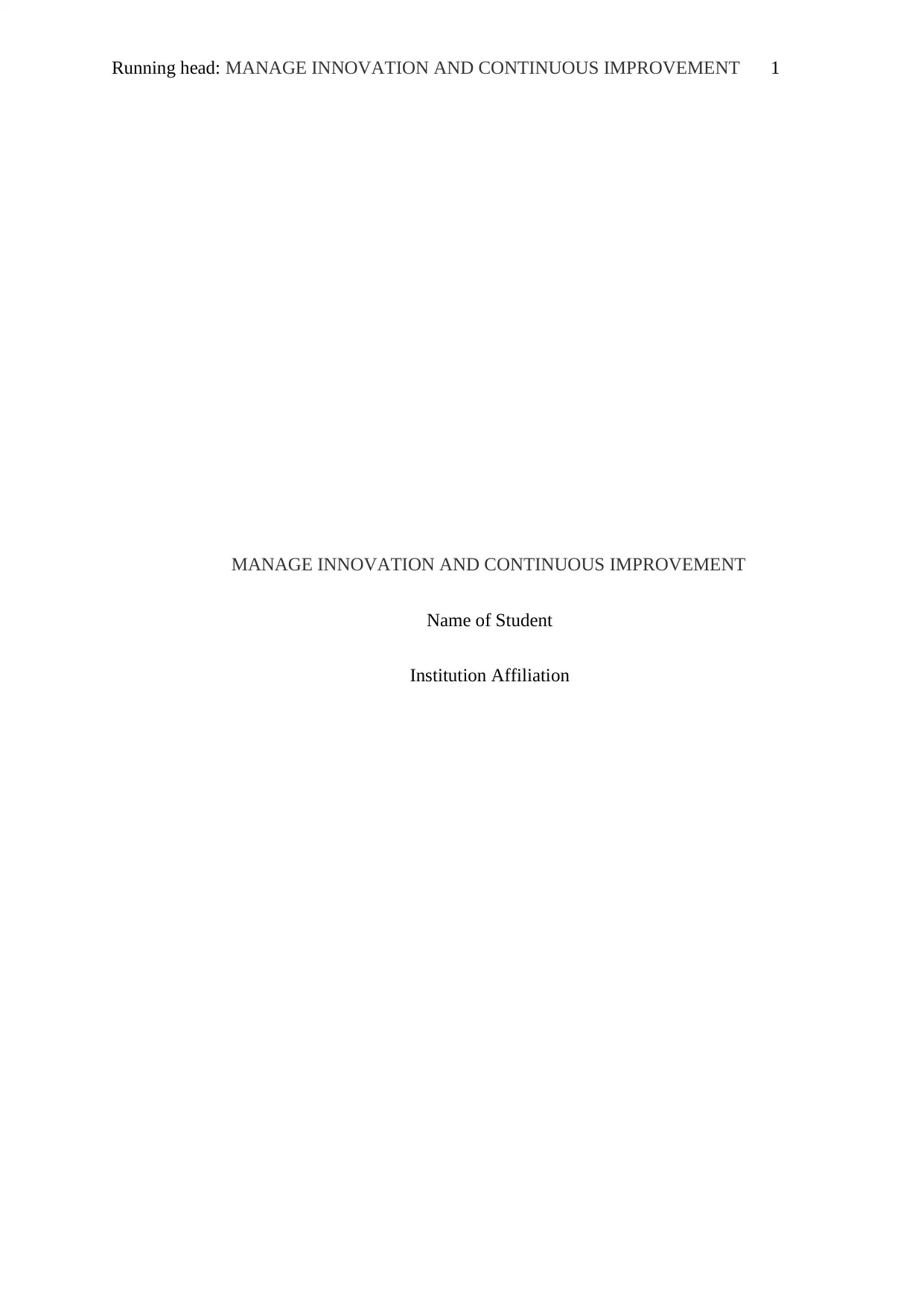
Running head: MANAGE INNOVATION AND CONTINUOUS IMPROVEMENT 1
MANAGE INNOVATION AND CONTINUOUS IMPROVEMENT
Name of Student
Institution Affiliation
MANAGE INNOVATION AND CONTINUOUS IMPROVEMENT
Name of Student
Institution Affiliation
Paraphrase This Document
Need a fresh take? Get an instant paraphrase of this document with our AI Paraphraser
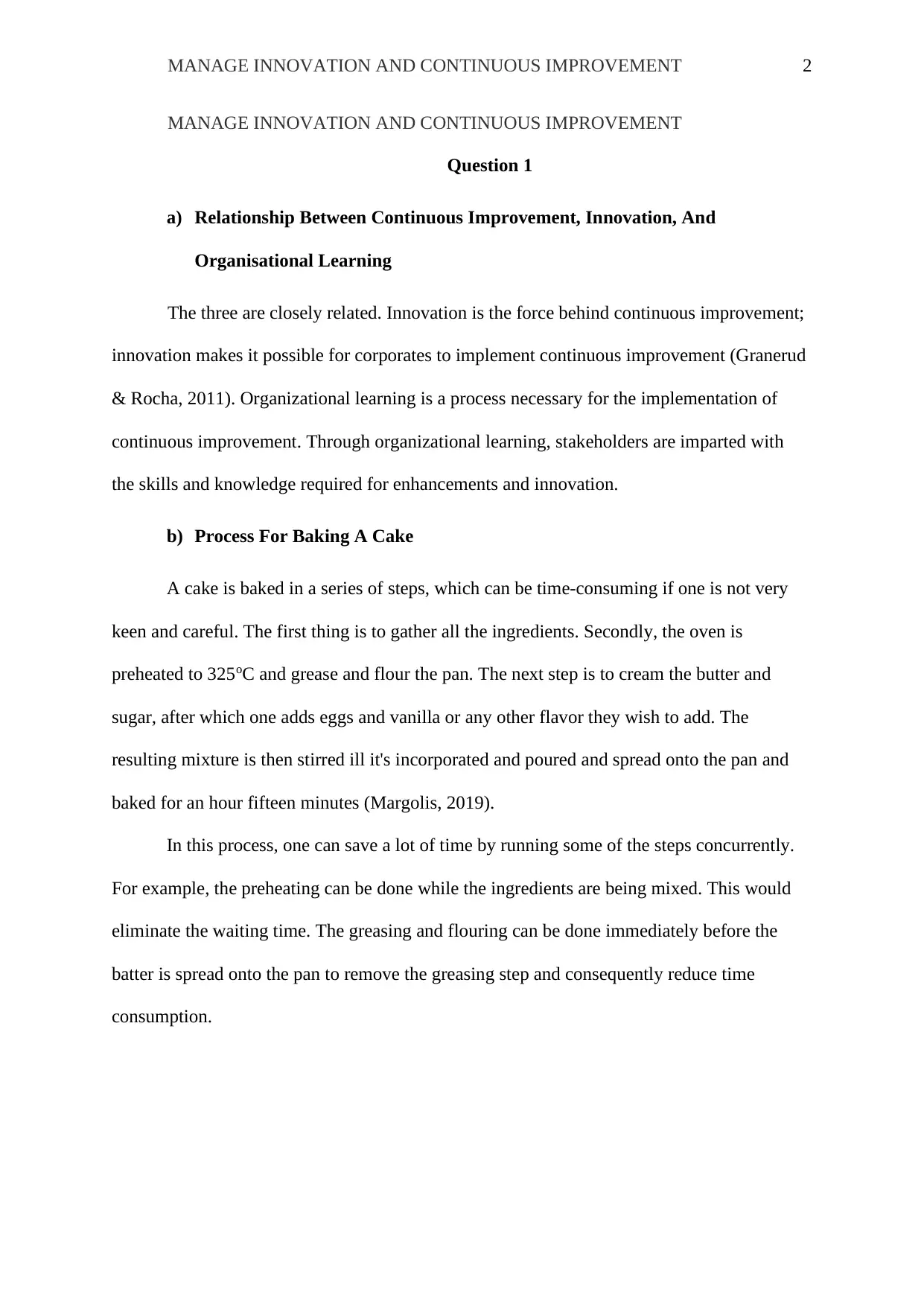
MANAGE INNOVATION AND CONTINUOUS IMPROVEMENT 2
MANAGE INNOVATION AND CONTINUOUS IMPROVEMENT
Question 1
a) Relationship Between Continuous Improvement, Innovation, And
Organisational Learning
The three are closely related. Innovation is the force behind continuous improvement;
innovation makes it possible for corporates to implement continuous improvement (Granerud
& Rocha, 2011). Organizational learning is a process necessary for the implementation of
continuous improvement. Through organizational learning, stakeholders are imparted with
the skills and knowledge required for enhancements and innovation.
b) Process For Baking A Cake
A cake is baked in a series of steps, which can be time-consuming if one is not very
keen and careful. The first thing is to gather all the ingredients. Secondly, the oven is
preheated to 325oC and grease and flour the pan. The next step is to cream the butter and
sugar, after which one adds eggs and vanilla or any other flavor they wish to add. The
resulting mixture is then stirred ill it's incorporated and poured and spread onto the pan and
baked for an hour fifteen minutes (Margolis, 2019).
In this process, one can save a lot of time by running some of the steps concurrently.
For example, the preheating can be done while the ingredients are being mixed. This would
eliminate the waiting time. The greasing and flouring can be done immediately before the
batter is spread onto the pan to remove the greasing step and consequently reduce time
consumption.
MANAGE INNOVATION AND CONTINUOUS IMPROVEMENT
Question 1
a) Relationship Between Continuous Improvement, Innovation, And
Organisational Learning
The three are closely related. Innovation is the force behind continuous improvement;
innovation makes it possible for corporates to implement continuous improvement (Granerud
& Rocha, 2011). Organizational learning is a process necessary for the implementation of
continuous improvement. Through organizational learning, stakeholders are imparted with
the skills and knowledge required for enhancements and innovation.
b) Process For Baking A Cake
A cake is baked in a series of steps, which can be time-consuming if one is not very
keen and careful. The first thing is to gather all the ingredients. Secondly, the oven is
preheated to 325oC and grease and flour the pan. The next step is to cream the butter and
sugar, after which one adds eggs and vanilla or any other flavor they wish to add. The
resulting mixture is then stirred ill it's incorporated and poured and spread onto the pan and
baked for an hour fifteen minutes (Margolis, 2019).
In this process, one can save a lot of time by running some of the steps concurrently.
For example, the preheating can be done while the ingredients are being mixed. This would
eliminate the waiting time. The greasing and flouring can be done immediately before the
batter is spread onto the pan to remove the greasing step and consequently reduce time
consumption.
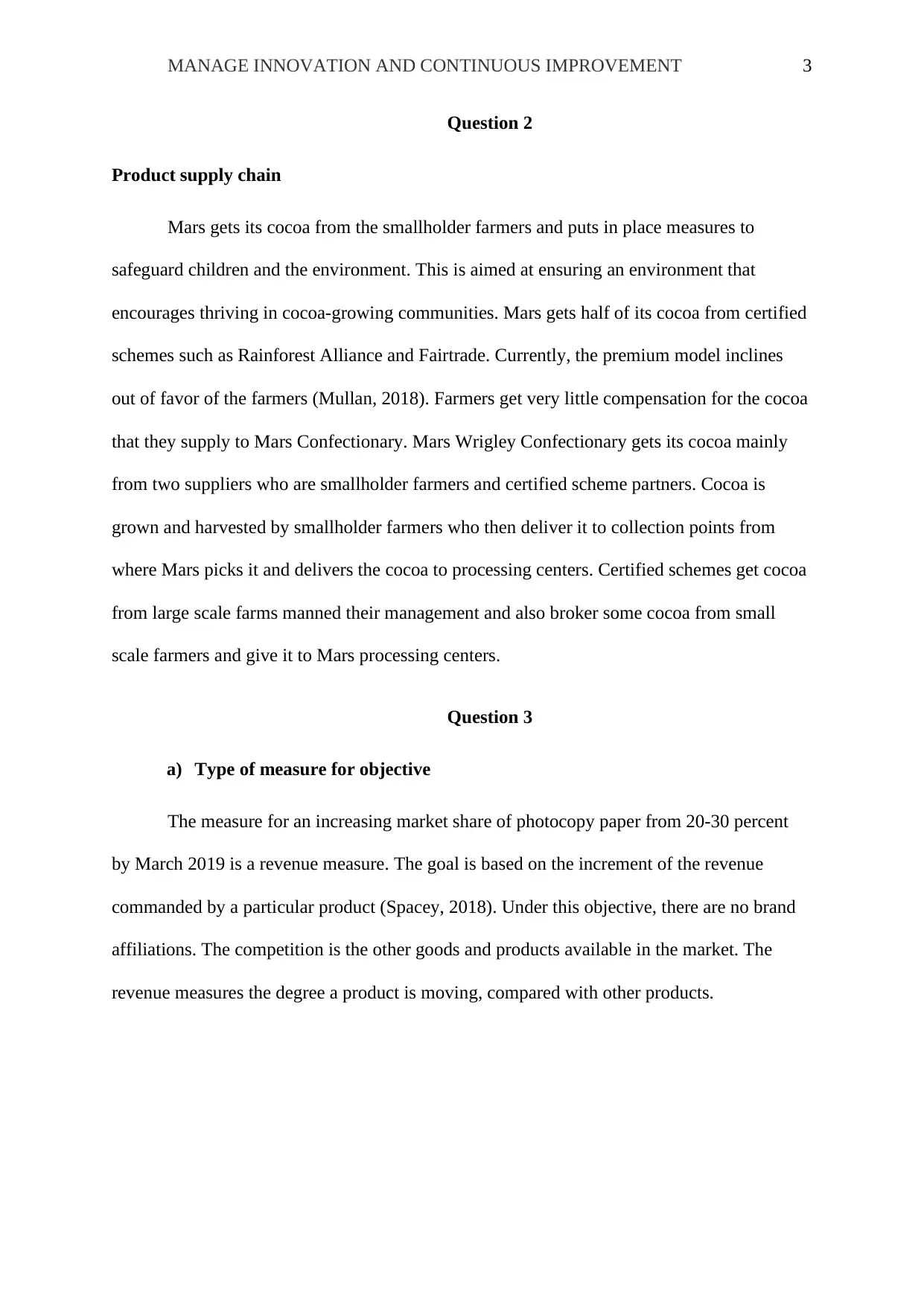
MANAGE INNOVATION AND CONTINUOUS IMPROVEMENT 3
Question 2
Product supply chain
Mars gets its cocoa from the smallholder farmers and puts in place measures to
safeguard children and the environment. This is aimed at ensuring an environment that
encourages thriving in cocoa-growing communities. Mars gets half of its cocoa from certified
schemes such as Rainforest Alliance and Fairtrade. Currently, the premium model inclines
out of favor of the farmers (Mullan, 2018). Farmers get very little compensation for the cocoa
that they supply to Mars Confectionary. Mars Wrigley Confectionary gets its cocoa mainly
from two suppliers who are smallholder farmers and certified scheme partners. Cocoa is
grown and harvested by smallholder farmers who then deliver it to collection points from
where Mars picks it and delivers the cocoa to processing centers. Certified schemes get cocoa
from large scale farms manned their management and also broker some cocoa from small
scale farmers and give it to Mars processing centers.
Question 3
a) Type of measure for objective
The measure for an increasing market share of photocopy paper from 20-30 percent
by March 2019 is a revenue measure. The goal is based on the increment of the revenue
commanded by a particular product (Spacey, 2018). Under this objective, there are no brand
affiliations. The competition is the other goods and products available in the market. The
revenue measures the degree a product is moving, compared with other products.
Question 2
Product supply chain
Mars gets its cocoa from the smallholder farmers and puts in place measures to
safeguard children and the environment. This is aimed at ensuring an environment that
encourages thriving in cocoa-growing communities. Mars gets half of its cocoa from certified
schemes such as Rainforest Alliance and Fairtrade. Currently, the premium model inclines
out of favor of the farmers (Mullan, 2018). Farmers get very little compensation for the cocoa
that they supply to Mars Confectionary. Mars Wrigley Confectionary gets its cocoa mainly
from two suppliers who are smallholder farmers and certified scheme partners. Cocoa is
grown and harvested by smallholder farmers who then deliver it to collection points from
where Mars picks it and delivers the cocoa to processing centers. Certified schemes get cocoa
from large scale farms manned their management and also broker some cocoa from small
scale farmers and give it to Mars processing centers.
Question 3
a) Type of measure for objective
The measure for an increasing market share of photocopy paper from 20-30 percent
by March 2019 is a revenue measure. The goal is based on the increment of the revenue
commanded by a particular product (Spacey, 2018). Under this objective, there are no brand
affiliations. The competition is the other goods and products available in the market. The
revenue measures the degree a product is moving, compared with other products.
⊘ This is a preview!⊘
Do you want full access?
Subscribe today to unlock all pages.

Trusted by 1+ million students worldwide
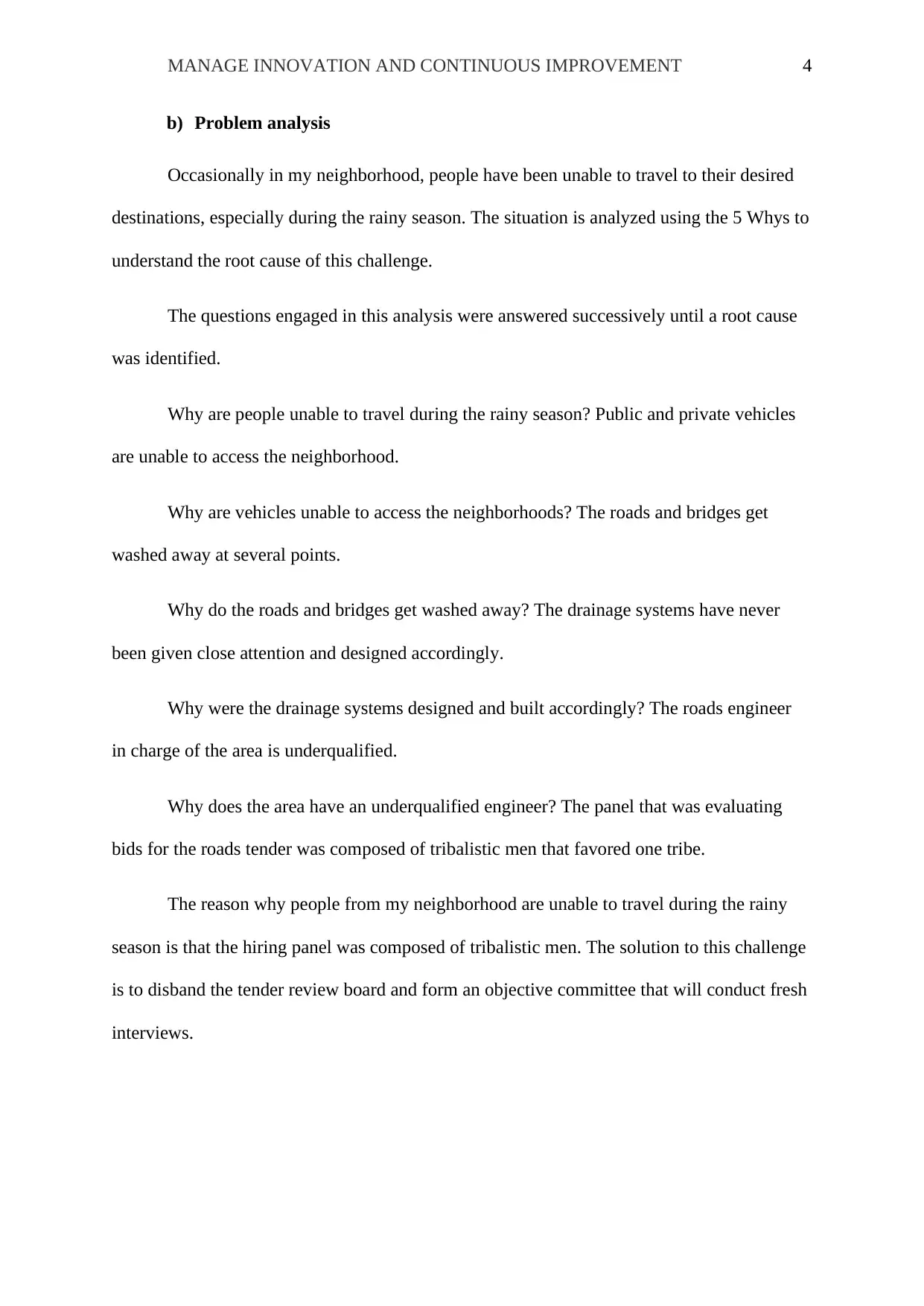
MANAGE INNOVATION AND CONTINUOUS IMPROVEMENT 4
b) Problem analysis
Occasionally in my neighborhood, people have been unable to travel to their desired
destinations, especially during the rainy season. The situation is analyzed using the 5 Whys to
understand the root cause of this challenge.
The questions engaged in this analysis were answered successively until a root cause
was identified.
Why are people unable to travel during the rainy season? Public and private vehicles
are unable to access the neighborhood.
Why are vehicles unable to access the neighborhoods? The roads and bridges get
washed away at several points.
Why do the roads and bridges get washed away? The drainage systems have never
been given close attention and designed accordingly.
Why were the drainage systems designed and built accordingly? The roads engineer
in charge of the area is underqualified.
Why does the area have an underqualified engineer? The panel that was evaluating
bids for the roads tender was composed of tribalistic men that favored one tribe.
The reason why people from my neighborhood are unable to travel during the rainy
season is that the hiring panel was composed of tribalistic men. The solution to this challenge
is to disband the tender review board and form an objective committee that will conduct fresh
interviews.
b) Problem analysis
Occasionally in my neighborhood, people have been unable to travel to their desired
destinations, especially during the rainy season. The situation is analyzed using the 5 Whys to
understand the root cause of this challenge.
The questions engaged in this analysis were answered successively until a root cause
was identified.
Why are people unable to travel during the rainy season? Public and private vehicles
are unable to access the neighborhood.
Why are vehicles unable to access the neighborhoods? The roads and bridges get
washed away at several points.
Why do the roads and bridges get washed away? The drainage systems have never
been given close attention and designed accordingly.
Why were the drainage systems designed and built accordingly? The roads engineer
in charge of the area is underqualified.
Why does the area have an underqualified engineer? The panel that was evaluating
bids for the roads tender was composed of tribalistic men that favored one tribe.
The reason why people from my neighborhood are unable to travel during the rainy
season is that the hiring panel was composed of tribalistic men. The solution to this challenge
is to disband the tender review board and form an objective committee that will conduct fresh
interviews.
Paraphrase This Document
Need a fresh take? Get an instant paraphrase of this document with our AI Paraphraser
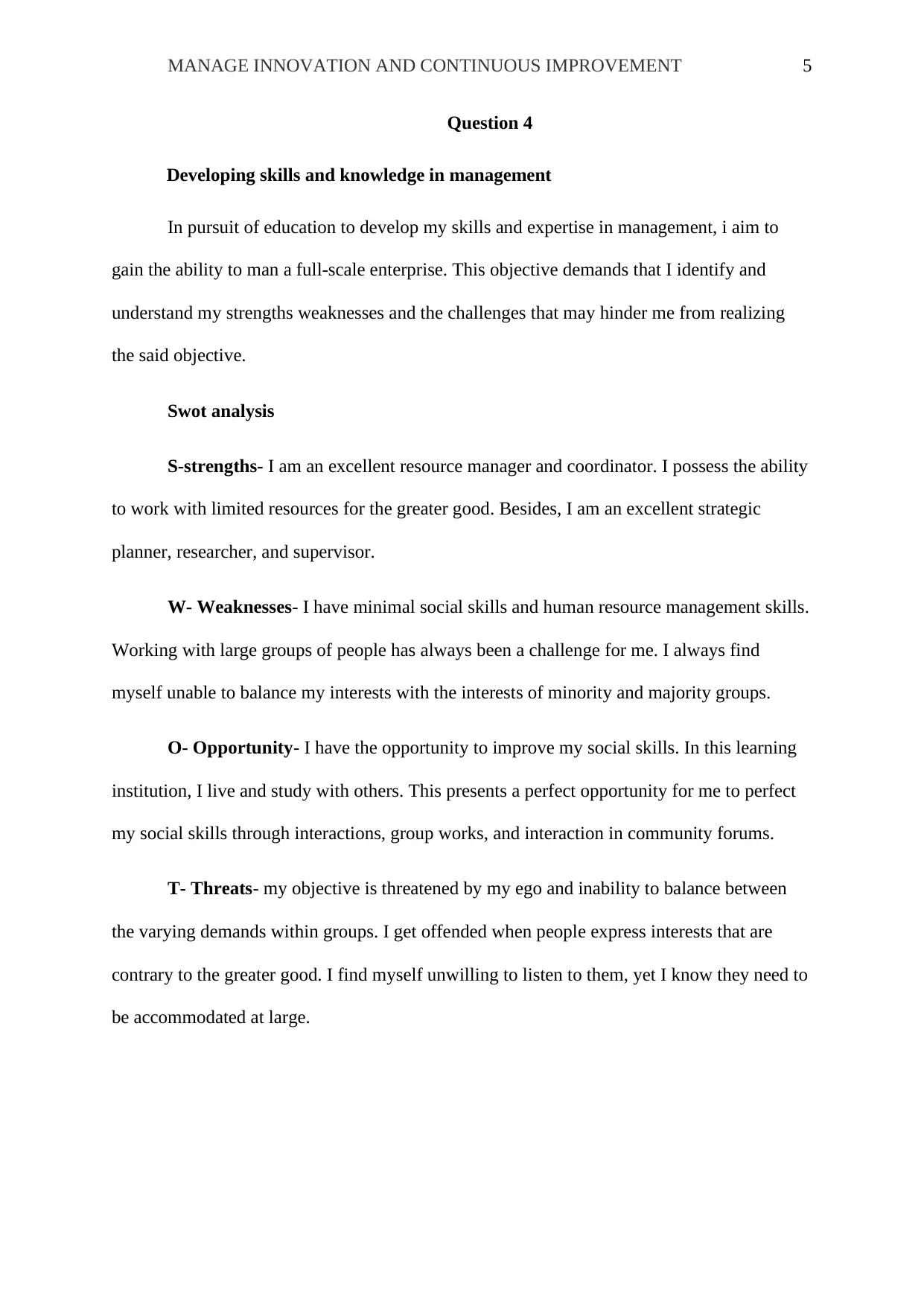
MANAGE INNOVATION AND CONTINUOUS IMPROVEMENT 5
Question 4
Developing skills and knowledge in management
In pursuit of education to develop my skills and expertise in management, i aim to
gain the ability to man a full-scale enterprise. This objective demands that I identify and
understand my strengths weaknesses and the challenges that may hinder me from realizing
the said objective.
Swot analysis
S-strengths- I am an excellent resource manager and coordinator. I possess the ability
to work with limited resources for the greater good. Besides, I am an excellent strategic
planner, researcher, and supervisor.
W- Weaknesses- I have minimal social skills and human resource management skills.
Working with large groups of people has always been a challenge for me. I always find
myself unable to balance my interests with the interests of minority and majority groups.
O- Opportunity- I have the opportunity to improve my social skills. In this learning
institution, I live and study with others. This presents a perfect opportunity for me to perfect
my social skills through interactions, group works, and interaction in community forums.
T- Threats- my objective is threatened by my ego and inability to balance between
the varying demands within groups. I get offended when people express interests that are
contrary to the greater good. I find myself unwilling to listen to them, yet I know they need to
be accommodated at large.
Question 4
Developing skills and knowledge in management
In pursuit of education to develop my skills and expertise in management, i aim to
gain the ability to man a full-scale enterprise. This objective demands that I identify and
understand my strengths weaknesses and the challenges that may hinder me from realizing
the said objective.
Swot analysis
S-strengths- I am an excellent resource manager and coordinator. I possess the ability
to work with limited resources for the greater good. Besides, I am an excellent strategic
planner, researcher, and supervisor.
W- Weaknesses- I have minimal social skills and human resource management skills.
Working with large groups of people has always been a challenge for me. I always find
myself unable to balance my interests with the interests of minority and majority groups.
O- Opportunity- I have the opportunity to improve my social skills. In this learning
institution, I live and study with others. This presents a perfect opportunity for me to perfect
my social skills through interactions, group works, and interaction in community forums.
T- Threats- my objective is threatened by my ego and inability to balance between
the varying demands within groups. I get offended when people express interests that are
contrary to the greater good. I find myself unwilling to listen to them, yet I know they need to
be accommodated at large.
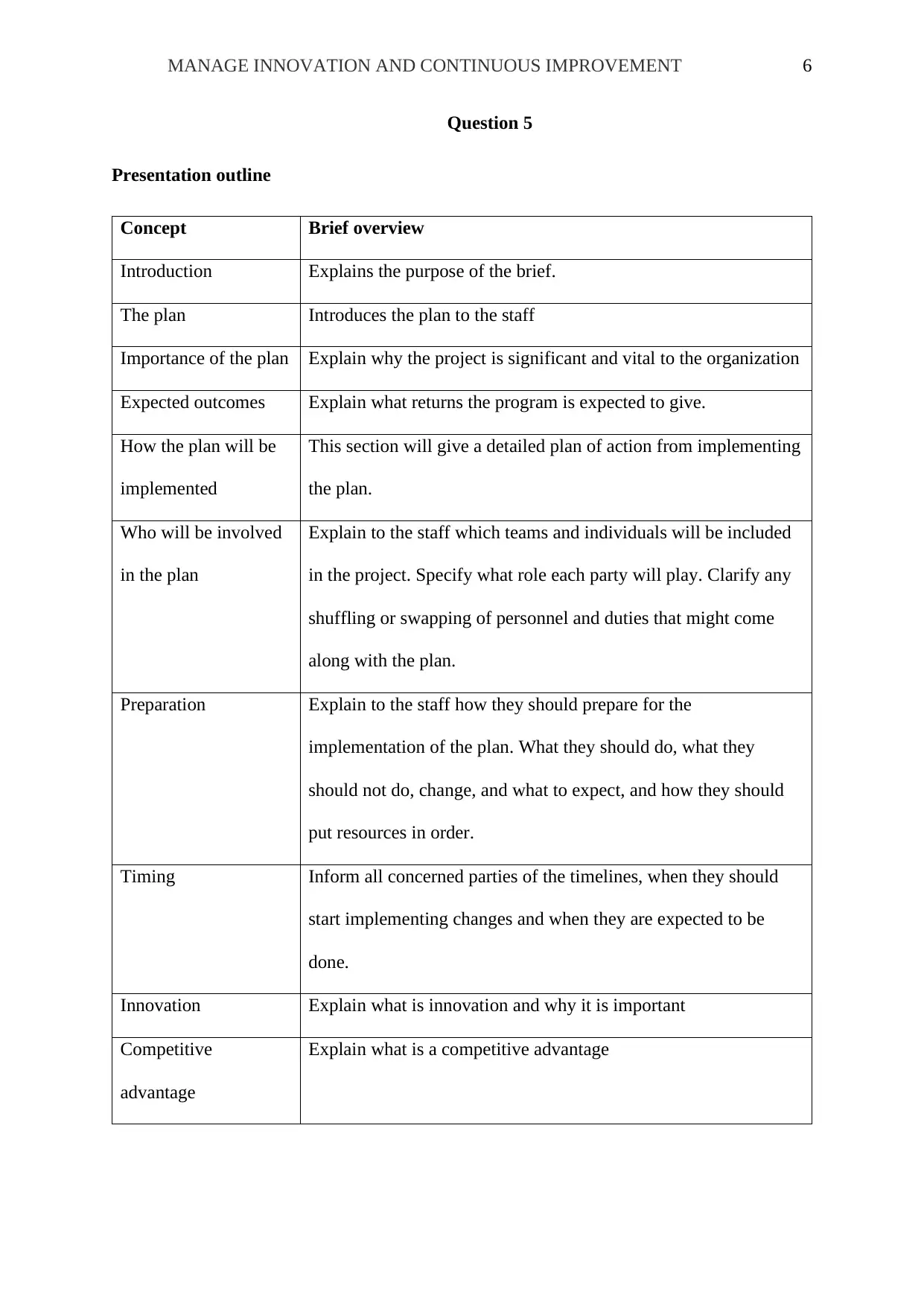
MANAGE INNOVATION AND CONTINUOUS IMPROVEMENT 6
Question 5
Presentation outline
Concept Brief overview
Introduction Explains the purpose of the brief.
The plan Introduces the plan to the staff
Importance of the plan Explain why the project is significant and vital to the organization
Expected outcomes Explain what returns the program is expected to give.
How the plan will be
implemented
This section will give a detailed plan of action from implementing
the plan.
Who will be involved
in the plan
Explain to the staff which teams and individuals will be included
in the project. Specify what role each party will play. Clarify any
shuffling or swapping of personnel and duties that might come
along with the plan.
Preparation Explain to the staff how they should prepare for the
implementation of the plan. What they should do, what they
should not do, change, and what to expect, and how they should
put resources in order.
Timing Inform all concerned parties of the timelines, when they should
start implementing changes and when they are expected to be
done.
Innovation Explain what is innovation and why it is important
Competitive
advantage
Explain what is a competitive advantage
Question 5
Presentation outline
Concept Brief overview
Introduction Explains the purpose of the brief.
The plan Introduces the plan to the staff
Importance of the plan Explain why the project is significant and vital to the organization
Expected outcomes Explain what returns the program is expected to give.
How the plan will be
implemented
This section will give a detailed plan of action from implementing
the plan.
Who will be involved
in the plan
Explain to the staff which teams and individuals will be included
in the project. Specify what role each party will play. Clarify any
shuffling or swapping of personnel and duties that might come
along with the plan.
Preparation Explain to the staff how they should prepare for the
implementation of the plan. What they should do, what they
should not do, change, and what to expect, and how they should
put resources in order.
Timing Inform all concerned parties of the timelines, when they should
start implementing changes and when they are expected to be
done.
Innovation Explain what is innovation and why it is important
Competitive
advantage
Explain what is a competitive advantage
⊘ This is a preview!⊘
Do you want full access?
Subscribe today to unlock all pages.

Trusted by 1+ million students worldwide
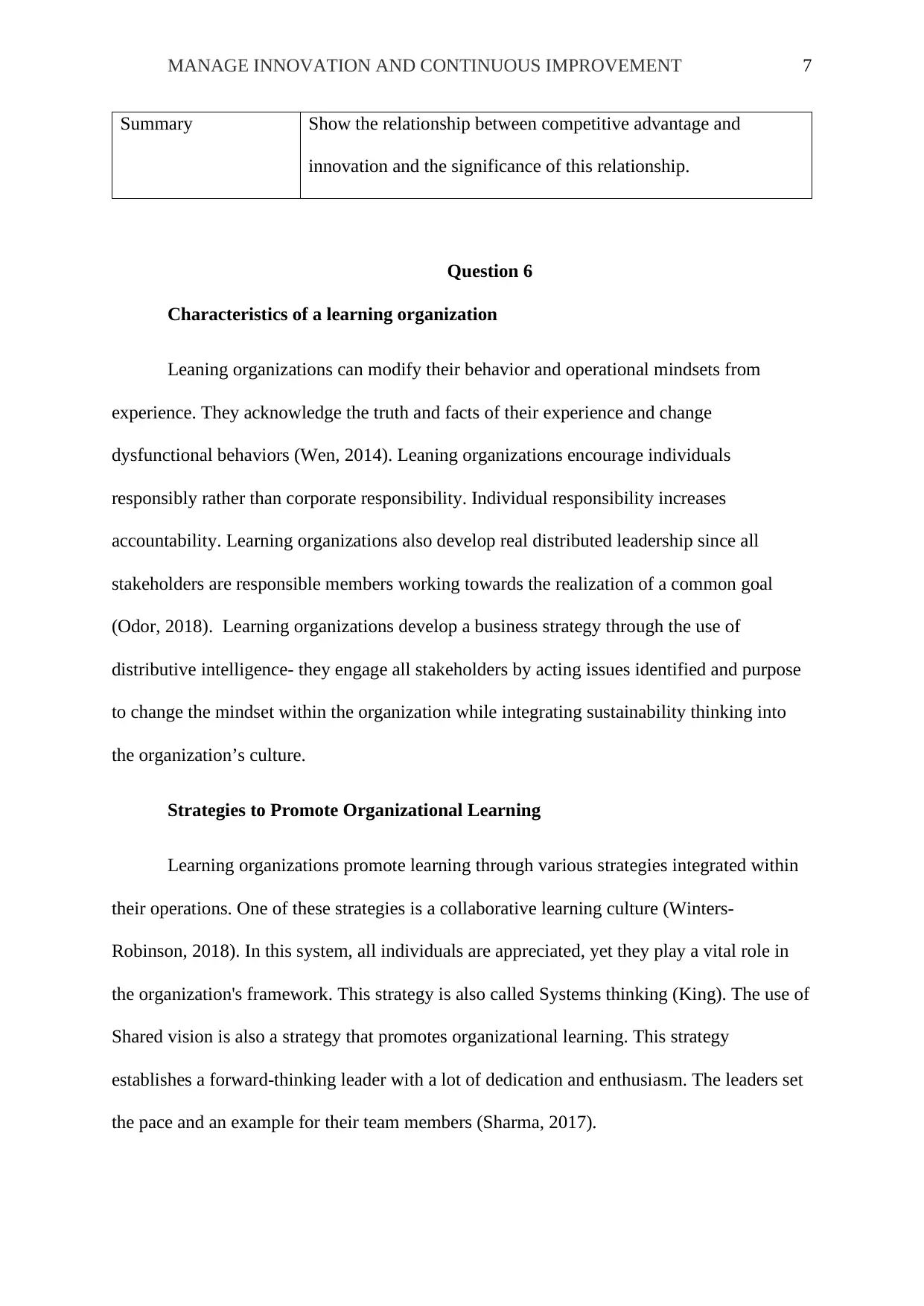
MANAGE INNOVATION AND CONTINUOUS IMPROVEMENT 7
Summary Show the relationship between competitive advantage and
innovation and the significance of this relationship.
Question 6
Characteristics of a learning organization
Leaning organizations can modify their behavior and operational mindsets from
experience. They acknowledge the truth and facts of their experience and change
dysfunctional behaviors (Wen, 2014). Leaning organizations encourage individuals
responsibly rather than corporate responsibility. Individual responsibility increases
accountability. Learning organizations also develop real distributed leadership since all
stakeholders are responsible members working towards the realization of a common goal
(Odor, 2018). Learning organizations develop a business strategy through the use of
distributive intelligence- they engage all stakeholders by acting issues identified and purpose
to change the mindset within the organization while integrating sustainability thinking into
the organization’s culture.
Strategies to Promote Organizational Learning
Learning organizations promote learning through various strategies integrated within
their operations. One of these strategies is a collaborative learning culture (Winters-
Robinson, 2018). In this system, all individuals are appreciated, yet they play a vital role in
the organization's framework. This strategy is also called Systems thinking (King). The use of
Shared vision is also a strategy that promotes organizational learning. This strategy
establishes a forward-thinking leader with a lot of dedication and enthusiasm. The leaders set
the pace and an example for their team members (Sharma, 2017).
Summary Show the relationship between competitive advantage and
innovation and the significance of this relationship.
Question 6
Characteristics of a learning organization
Leaning organizations can modify their behavior and operational mindsets from
experience. They acknowledge the truth and facts of their experience and change
dysfunctional behaviors (Wen, 2014). Leaning organizations encourage individuals
responsibly rather than corporate responsibility. Individual responsibility increases
accountability. Learning organizations also develop real distributed leadership since all
stakeholders are responsible members working towards the realization of a common goal
(Odor, 2018). Learning organizations develop a business strategy through the use of
distributive intelligence- they engage all stakeholders by acting issues identified and purpose
to change the mindset within the organization while integrating sustainability thinking into
the organization’s culture.
Strategies to Promote Organizational Learning
Learning organizations promote learning through various strategies integrated within
their operations. One of these strategies is a collaborative learning culture (Winters-
Robinson, 2018). In this system, all individuals are appreciated, yet they play a vital role in
the organization's framework. This strategy is also called Systems thinking (King). The use of
Shared vision is also a strategy that promotes organizational learning. This strategy
establishes a forward-thinking leader with a lot of dedication and enthusiasm. The leaders set
the pace and an example for their team members (Sharma, 2017).
Paraphrase This Document
Need a fresh take? Get an instant paraphrase of this document with our AI Paraphraser
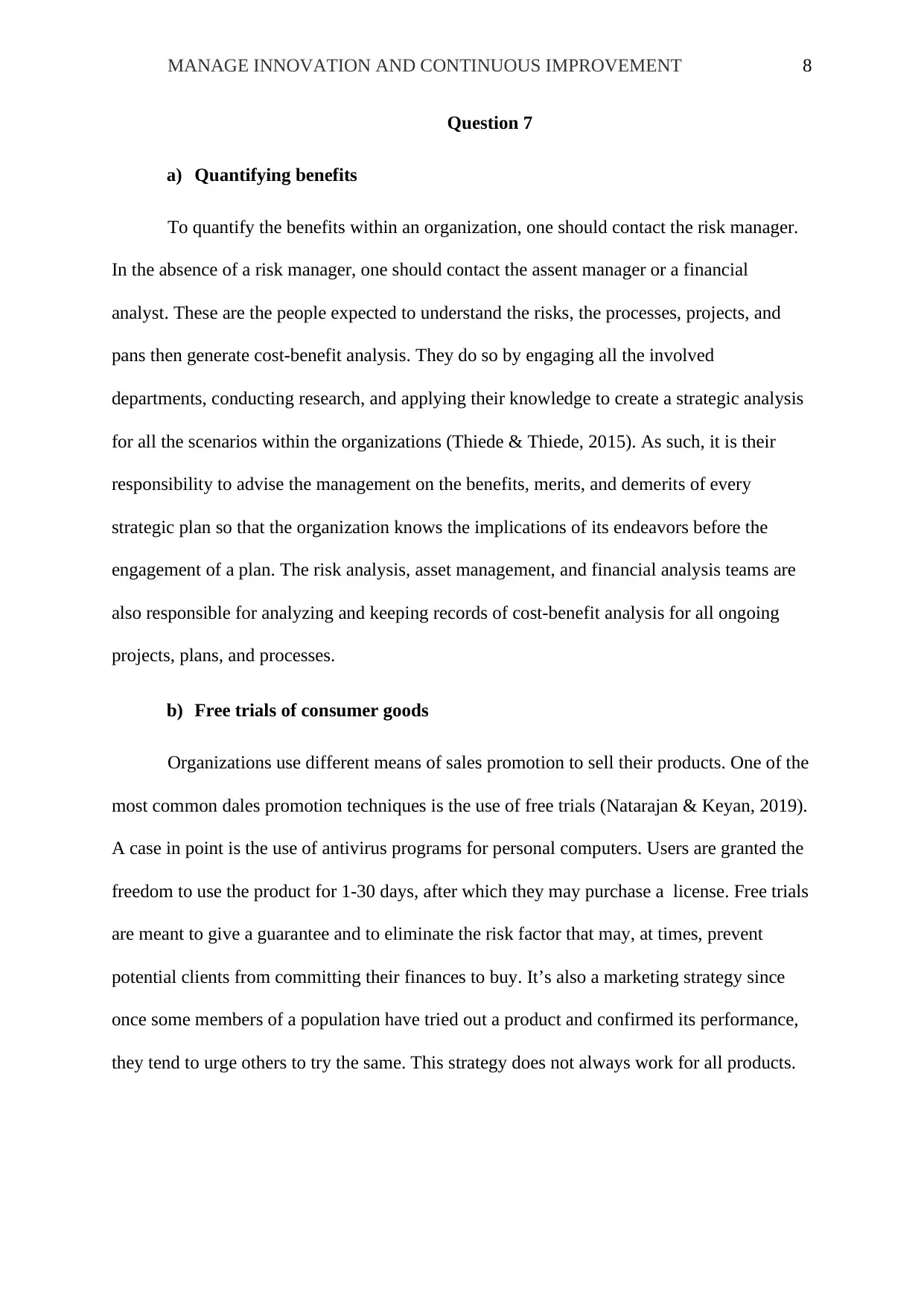
MANAGE INNOVATION AND CONTINUOUS IMPROVEMENT 8
Question 7
a) Quantifying benefits
To quantify the benefits within an organization, one should contact the risk manager.
In the absence of a risk manager, one should contact the assent manager or a financial
analyst. These are the people expected to understand the risks, the processes, projects, and
pans then generate cost-benefit analysis. They do so by engaging all the involved
departments, conducting research, and applying their knowledge to create a strategic analysis
for all the scenarios within the organizations (Thiede & Thiede, 2015). As such, it is their
responsibility to advise the management on the benefits, merits, and demerits of every
strategic plan so that the organization knows the implications of its endeavors before the
engagement of a plan. The risk analysis, asset management, and financial analysis teams are
also responsible for analyzing and keeping records of cost-benefit analysis for all ongoing
projects, plans, and processes.
b) Free trials of consumer goods
Organizations use different means of sales promotion to sell their products. One of the
most common dales promotion techniques is the use of free trials (Natarajan & Keyan, 2019).
A case in point is the use of antivirus programs for personal computers. Users are granted the
freedom to use the product for 1-30 days, after which they may purchase a license. Free trials
are meant to give a guarantee and to eliminate the risk factor that may, at times, prevent
potential clients from committing their finances to buy. It’s also a marketing strategy since
once some members of a population have tried out a product and confirmed its performance,
they tend to urge others to try the same. This strategy does not always work for all products.
Question 7
a) Quantifying benefits
To quantify the benefits within an organization, one should contact the risk manager.
In the absence of a risk manager, one should contact the assent manager or a financial
analyst. These are the people expected to understand the risks, the processes, projects, and
pans then generate cost-benefit analysis. They do so by engaging all the involved
departments, conducting research, and applying their knowledge to create a strategic analysis
for all the scenarios within the organizations (Thiede & Thiede, 2015). As such, it is their
responsibility to advise the management on the benefits, merits, and demerits of every
strategic plan so that the organization knows the implications of its endeavors before the
engagement of a plan. The risk analysis, asset management, and financial analysis teams are
also responsible for analyzing and keeping records of cost-benefit analysis for all ongoing
projects, plans, and processes.
b) Free trials of consumer goods
Organizations use different means of sales promotion to sell their products. One of the
most common dales promotion techniques is the use of free trials (Natarajan & Keyan, 2019).
A case in point is the use of antivirus programs for personal computers. Users are granted the
freedom to use the product for 1-30 days, after which they may purchase a license. Free trials
are meant to give a guarantee and to eliminate the risk factor that may, at times, prevent
potential clients from committing their finances to buy. It’s also a marketing strategy since
once some members of a population have tried out a product and confirmed its performance,
they tend to urge others to try the same. This strategy does not always work for all products.
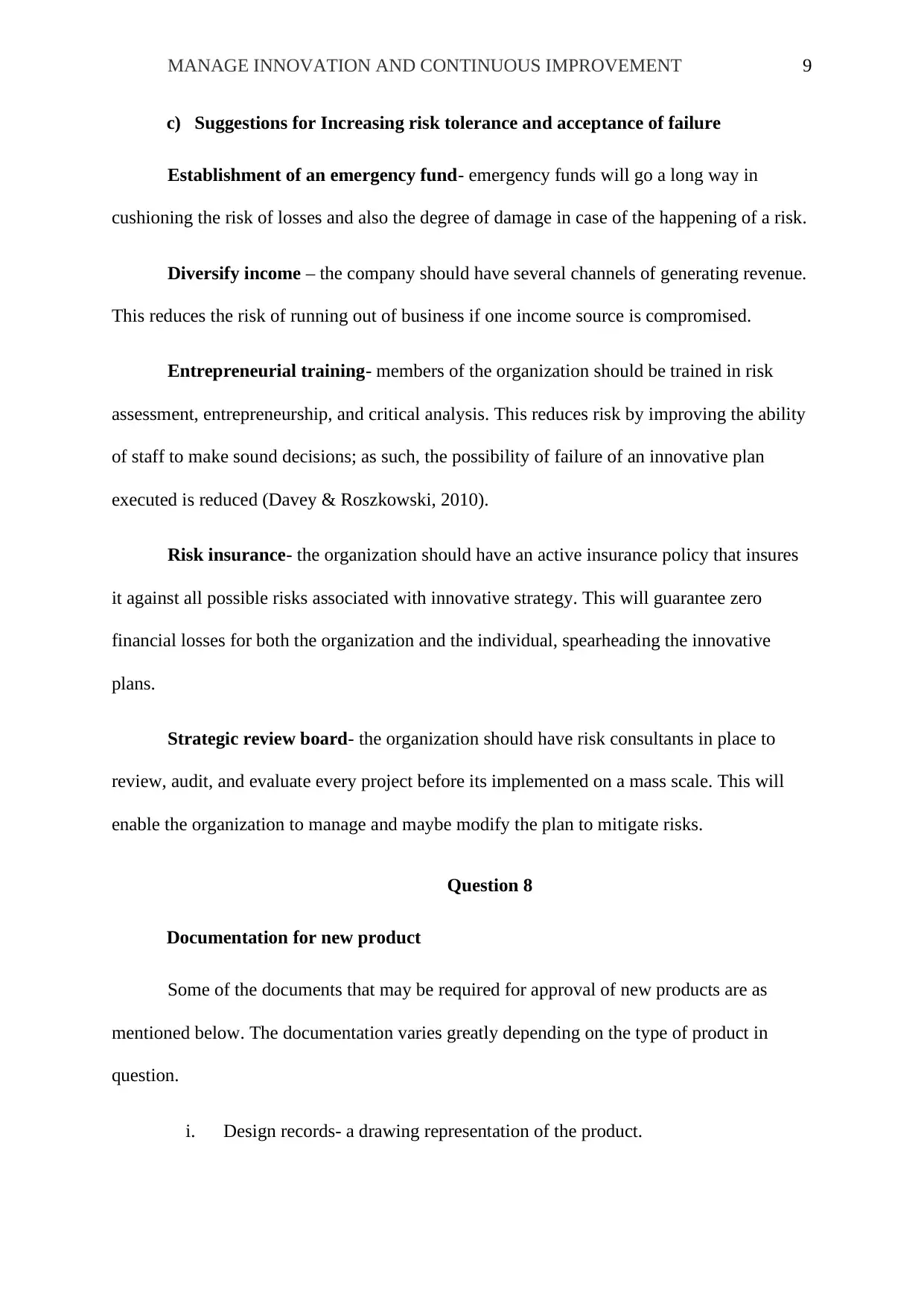
MANAGE INNOVATION AND CONTINUOUS IMPROVEMENT 9
c) Suggestions for Increasing risk tolerance and acceptance of failure
Establishment of an emergency fund- emergency funds will go a long way in
cushioning the risk of losses and also the degree of damage in case of the happening of a risk.
Diversify income – the company should have several channels of generating revenue.
This reduces the risk of running out of business if one income source is compromised.
Entrepreneurial training- members of the organization should be trained in risk
assessment, entrepreneurship, and critical analysis. This reduces risk by improving the ability
of staff to make sound decisions; as such, the possibility of failure of an innovative plan
executed is reduced (Davey & Roszkowski, 2010).
Risk insurance- the organization should have an active insurance policy that insures
it against all possible risks associated with innovative strategy. This will guarantee zero
financial losses for both the organization and the individual, spearheading the innovative
plans.
Strategic review board- the organization should have risk consultants in place to
review, audit, and evaluate every project before its implemented on a mass scale. This will
enable the organization to manage and maybe modify the plan to mitigate risks.
Question 8
Documentation for new product
Some of the documents that may be required for approval of new products are as
mentioned below. The documentation varies greatly depending on the type of product in
question.
i. Design records- a drawing representation of the product.
c) Suggestions for Increasing risk tolerance and acceptance of failure
Establishment of an emergency fund- emergency funds will go a long way in
cushioning the risk of losses and also the degree of damage in case of the happening of a risk.
Diversify income – the company should have several channels of generating revenue.
This reduces the risk of running out of business if one income source is compromised.
Entrepreneurial training- members of the organization should be trained in risk
assessment, entrepreneurship, and critical analysis. This reduces risk by improving the ability
of staff to make sound decisions; as such, the possibility of failure of an innovative plan
executed is reduced (Davey & Roszkowski, 2010).
Risk insurance- the organization should have an active insurance policy that insures
it against all possible risks associated with innovative strategy. This will guarantee zero
financial losses for both the organization and the individual, spearheading the innovative
plans.
Strategic review board- the organization should have risk consultants in place to
review, audit, and evaluate every project before its implemented on a mass scale. This will
enable the organization to manage and maybe modify the plan to mitigate risks.
Question 8
Documentation for new product
Some of the documents that may be required for approval of new products are as
mentioned below. The documentation varies greatly depending on the type of product in
question.
i. Design records- a drawing representation of the product.
⊘ This is a preview!⊘
Do you want full access?
Subscribe today to unlock all pages.

Trusted by 1+ million students worldwide
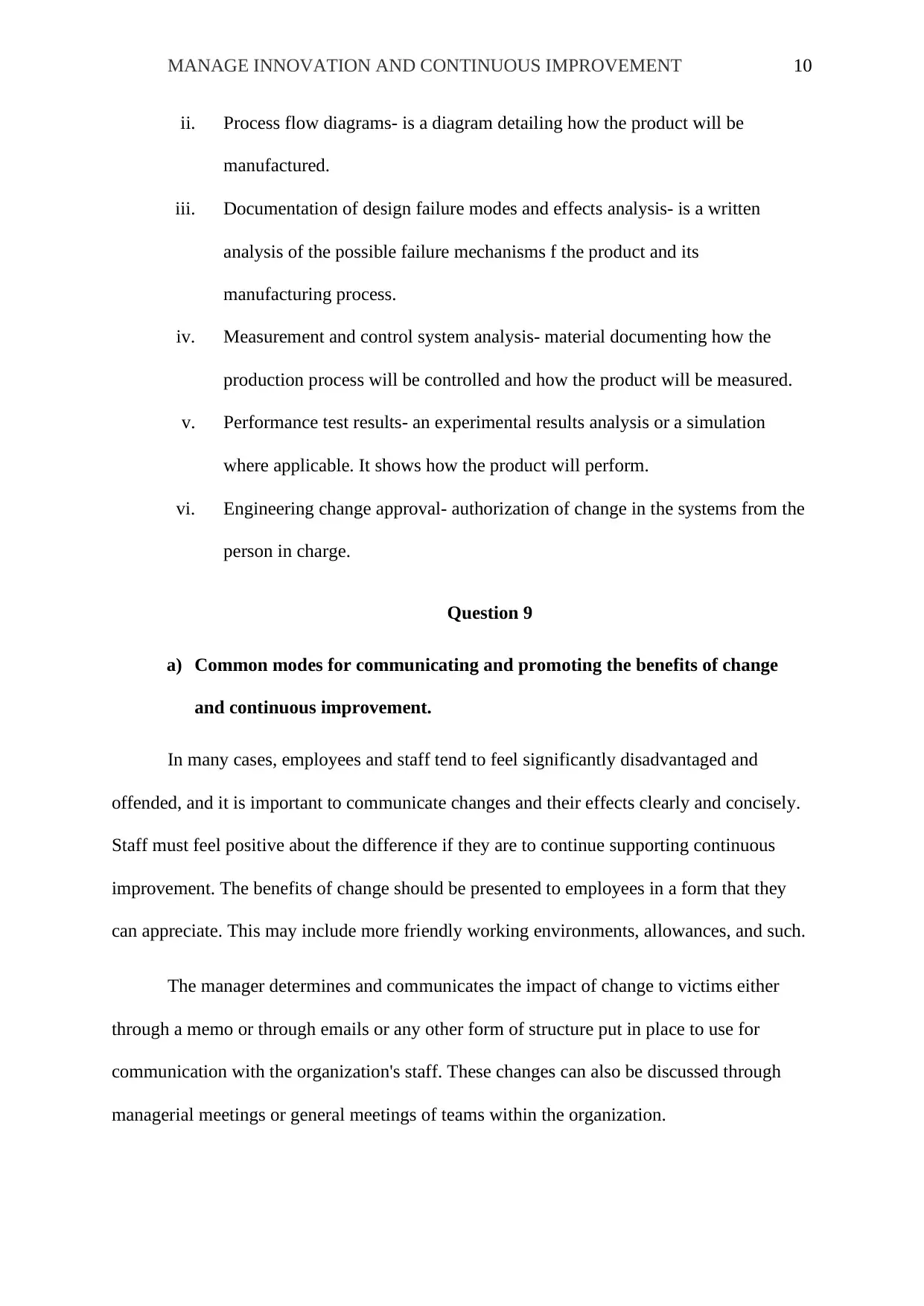
MANAGE INNOVATION AND CONTINUOUS IMPROVEMENT 10
ii. Process flow diagrams- is a diagram detailing how the product will be
manufactured.
iii. Documentation of design failure modes and effects analysis- is a written
analysis of the possible failure mechanisms f the product and its
manufacturing process.
iv. Measurement and control system analysis- material documenting how the
production process will be controlled and how the product will be measured.
v. Performance test results- an experimental results analysis or a simulation
where applicable. It shows how the product will perform.
vi. Engineering change approval- authorization of change in the systems from the
person in charge.
Question 9
a) Common modes for communicating and promoting the benefits of change
and continuous improvement.
In many cases, employees and staff tend to feel significantly disadvantaged and
offended, and it is important to communicate changes and their effects clearly and concisely.
Staff must feel positive about the difference if they are to continue supporting continuous
improvement. The benefits of change should be presented to employees in a form that they
can appreciate. This may include more friendly working environments, allowances, and such.
The manager determines and communicates the impact of change to victims either
through a memo or through emails or any other form of structure put in place to use for
communication with the organization's staff. These changes can also be discussed through
managerial meetings or general meetings of teams within the organization.
ii. Process flow diagrams- is a diagram detailing how the product will be
manufactured.
iii. Documentation of design failure modes and effects analysis- is a written
analysis of the possible failure mechanisms f the product and its
manufacturing process.
iv. Measurement and control system analysis- material documenting how the
production process will be controlled and how the product will be measured.
v. Performance test results- an experimental results analysis or a simulation
where applicable. It shows how the product will perform.
vi. Engineering change approval- authorization of change in the systems from the
person in charge.
Question 9
a) Common modes for communicating and promoting the benefits of change
and continuous improvement.
In many cases, employees and staff tend to feel significantly disadvantaged and
offended, and it is important to communicate changes and their effects clearly and concisely.
Staff must feel positive about the difference if they are to continue supporting continuous
improvement. The benefits of change should be presented to employees in a form that they
can appreciate. This may include more friendly working environments, allowances, and such.
The manager determines and communicates the impact of change to victims either
through a memo or through emails or any other form of structure put in place to use for
communication with the organization's staff. These changes can also be discussed through
managerial meetings or general meetings of teams within the organization.
Paraphrase This Document
Need a fresh take? Get an instant paraphrase of this document with our AI Paraphraser
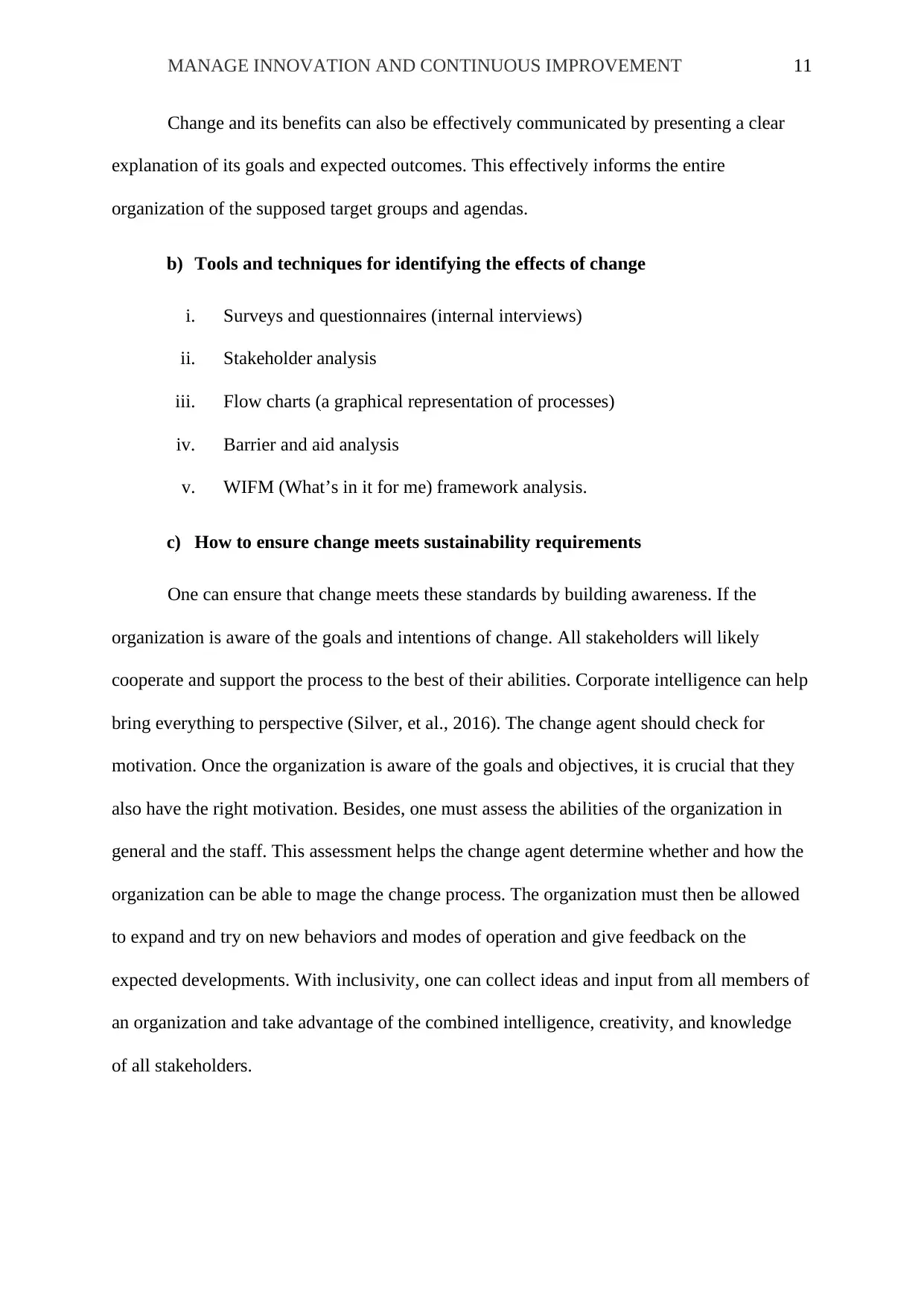
MANAGE INNOVATION AND CONTINUOUS IMPROVEMENT 11
Change and its benefits can also be effectively communicated by presenting a clear
explanation of its goals and expected outcomes. This effectively informs the entire
organization of the supposed target groups and agendas.
b) Tools and techniques for identifying the effects of change
i. Surveys and questionnaires (internal interviews)
ii. Stakeholder analysis
iii. Flow charts (a graphical representation of processes)
iv. Barrier and aid analysis
v. WIFM (What’s in it for me) framework analysis.
c) How to ensure change meets sustainability requirements
One can ensure that change meets these standards by building awareness. If the
organization is aware of the goals and intentions of change. All stakeholders will likely
cooperate and support the process to the best of their abilities. Corporate intelligence can help
bring everything to perspective (Silver, et al., 2016). The change agent should check for
motivation. Once the organization is aware of the goals and objectives, it is crucial that they
also have the right motivation. Besides, one must assess the abilities of the organization in
general and the staff. This assessment helps the change agent determine whether and how the
organization can be able to mage the change process. The organization must then be allowed
to expand and try on new behaviors and modes of operation and give feedback on the
expected developments. With inclusivity, one can collect ideas and input from all members of
an organization and take advantage of the combined intelligence, creativity, and knowledge
of all stakeholders.
Change and its benefits can also be effectively communicated by presenting a clear
explanation of its goals and expected outcomes. This effectively informs the entire
organization of the supposed target groups and agendas.
b) Tools and techniques for identifying the effects of change
i. Surveys and questionnaires (internal interviews)
ii. Stakeholder analysis
iii. Flow charts (a graphical representation of processes)
iv. Barrier and aid analysis
v. WIFM (What’s in it for me) framework analysis.
c) How to ensure change meets sustainability requirements
One can ensure that change meets these standards by building awareness. If the
organization is aware of the goals and intentions of change. All stakeholders will likely
cooperate and support the process to the best of their abilities. Corporate intelligence can help
bring everything to perspective (Silver, et al., 2016). The change agent should check for
motivation. Once the organization is aware of the goals and objectives, it is crucial that they
also have the right motivation. Besides, one must assess the abilities of the organization in
general and the staff. This assessment helps the change agent determine whether and how the
organization can be able to mage the change process. The organization must then be allowed
to expand and try on new behaviors and modes of operation and give feedback on the
expected developments. With inclusivity, one can collect ideas and input from all members of
an organization and take advantage of the combined intelligence, creativity, and knowledge
of all stakeholders.
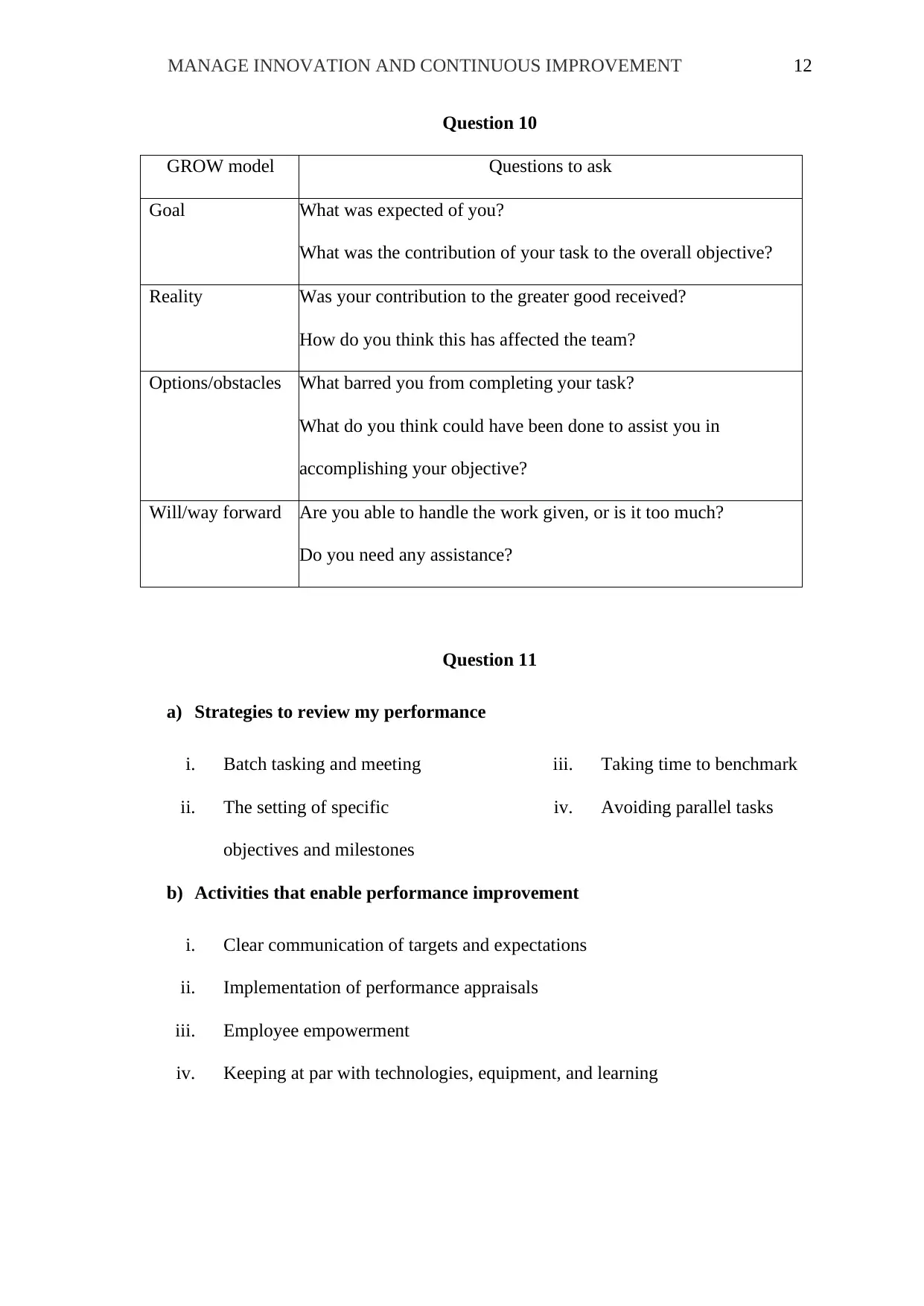
MANAGE INNOVATION AND CONTINUOUS IMPROVEMENT 12
Question 10
GROW model Questions to ask
Goal What was expected of you?
What was the contribution of your task to the overall objective?
Reality Was your contribution to the greater good received?
How do you think this has affected the team?
Options/obstacles What barred you from completing your task?
What do you think could have been done to assist you in
accomplishing your objective?
Will/way forward Are you able to handle the work given, or is it too much?
Do you need any assistance?
Question 11
a) Strategies to review my performance
i. Batch tasking and meeting
ii. The setting of specific
objectives and milestones
iii. Taking time to benchmark
iv. Avoiding parallel tasks
b) Activities that enable performance improvement
i. Clear communication of targets and expectations
ii. Implementation of performance appraisals
iii. Employee empowerment
iv. Keeping at par with technologies, equipment, and learning
Question 10
GROW model Questions to ask
Goal What was expected of you?
What was the contribution of your task to the overall objective?
Reality Was your contribution to the greater good received?
How do you think this has affected the team?
Options/obstacles What barred you from completing your task?
What do you think could have been done to assist you in
accomplishing your objective?
Will/way forward Are you able to handle the work given, or is it too much?
Do you need any assistance?
Question 11
a) Strategies to review my performance
i. Batch tasking and meeting
ii. The setting of specific
objectives and milestones
iii. Taking time to benchmark
iv. Avoiding parallel tasks
b) Activities that enable performance improvement
i. Clear communication of targets and expectations
ii. Implementation of performance appraisals
iii. Employee empowerment
iv. Keeping at par with technologies, equipment, and learning
⊘ This is a preview!⊘
Do you want full access?
Subscribe today to unlock all pages.

Trusted by 1+ million students worldwide
1 out of 18
Your All-in-One AI-Powered Toolkit for Academic Success.
+13062052269
info@desklib.com
Available 24*7 on WhatsApp / Email
![[object Object]](/_next/static/media/star-bottom.7253800d.svg)
Unlock your academic potential
Copyright © 2020–2025 A2Z Services. All Rights Reserved. Developed and managed by ZUCOL.
